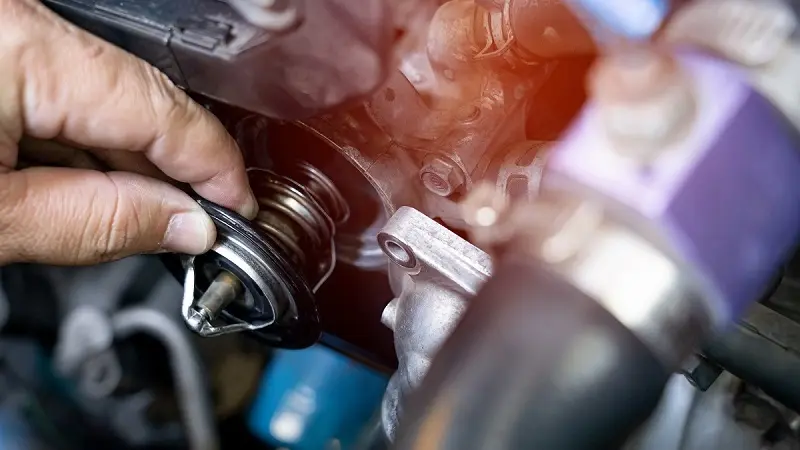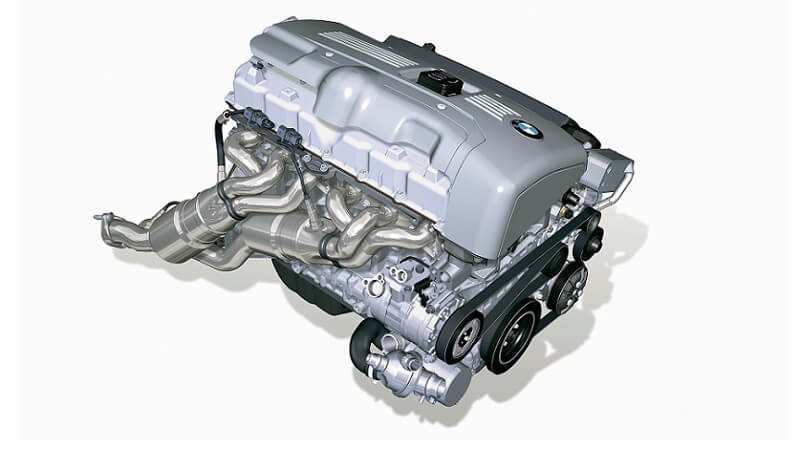The engine thermostat plays a crucial role in regulating the temperature of your BMW’s engine. A properly functioning thermostat helps to maintain the engine’s temperature within a safe range, which ensures optimal performance and efficiency. However, when the thermostat fails, it can lead to a number of issues. In this guide, we’ll cover the causes of a failed thermostat, most common symptoms, how to troubleshoot a bad thermostat, and how to fix it.

What Is a Thermostat, and How Does It Work?
The purpose of the thermostat is to keep the engine operating within its optimal temperature range. When the engine is running, it generates heat, which can cause damage to the engine if it’s not properly managed.
The thermostat helps prevent this by regulating the flow of coolant through the engine. When the engine is cold, the thermostat is closed, preventing coolant from circulating through the engine. This allows the engine to warm up quickly to its optimal operating temperature. Once the engine reaches its optimal temperature, the thermostat opens, allowing coolant to circulate through the engine and maintain a consistent temperature.
The thermostat works by using a wax pellet or a spring to control the valve that regulates the flow of coolant. When the engine is cold, the wax pellet or spring keeps the valve closed, preventing coolant from circulating through the engine.
As the engine warms up, the wax pellet or spring expands, causing the valve to open and allowing coolant to circulate through the engine. This allows the engine to maintain a consistent temperature and prevent damage caused by overheating or operating at a temperature that is too low.
In addition to regulating the engine temperature, the thermostat also helps to improve fuel economy. When the engine is running at its optimal temperature, it’s more efficient and burns fuel more effectively. This can help to reduce fuel costs and improve the overall performance of the vehicle.
Common Causes of a Failed Thermostat

Thermostats wear out over time, however that the usual wear and tear is not the only reason why this component fails. Here’s a more elaborate list of the most common causes of failed thermostats.
Wear and Tear
As the thermostat ages, the spring, valve, and other components can become worn and lose their ability to function properly. This can cause the thermostat to become stuck in an open position, which prevents it from properly regulating the engine’s temperature. In some cases, the thermostat can become stuck in a closed position, which can cause the engine to overheat.
Debris
Over time, debris and sediment can accumulate in the coolant system and cause the thermostat to stick. This can happen if the coolant hasn’t been changed regularly or if the vehicle has been driven in dusty or dirty conditions. That’s why it’s highly recommended that you flush your coolant regularly. When debris and sediment build up in the coolant system, they can cause the thermostat to become stuck in an open or closed position, which can result in poor engine performance and overheating.
Manufacturing Defect
In some cases, a manufacturing defect may cause the thermostat to fail prematurely. This is rare, but it can happen. For example, the valve in the thermostat may not be properly aligned, or the spring may be too weak or too strong. When this happens, the thermostat may not function properly, leading to engine performance issues and other problems.
Incorrect Installation
If the thermostat is installed incorrectly, it may not function properly, leading to failure. For example, if the thermostat is installed upside down or the gasket is installed incorrectly, it may not seal properly and can cause problems. When installing a new thermostat, it’s important to follow the manufacturer’s instructions carefully to ensure that it’s installed correctly.
If you’re looking for quality replacement thermostats, check our catalog!
Most Common Symptoms of a Bad Thermostat
Being able to recognize the early symptoms of a failing thermostat can save you a lot of trouble in the near future. For one, understanding these symptoms reduces the risk of you being stuck somewhere on the side of the road with an overheated engine. Here are the most common symptoms to look for.
Engine Running Hot or Cold
If your engine is running hot, especially in moderate traffic, that is one of the most straightforward signs that something is up with your cooling system. If the cooling fans are running fine, and you’re not leaking coolant anywhere, there’s a good chance that your thermostat is malfunctioning. In this case it’s likely stuck in a closed position. On the other hand, if the engine is running cold, it is likely stuck in the open position.
Poor Fuel Economy
A failed thermostat can cause the engine to take longer to reach operating temperature, which can result in reduced fuel economy. When the engine is running at a lower temperature, it’s less efficient and burns more fuel, leading to higher fuel costs.
Reduced Engine Performance
An engine that is operating at a temperature that is too low may have reduced power output, acceleration, and overall performance. This is because the engine is designed to operate within a specific temperature range, and if it’s running too cold, it may not function properly.
Coolant Leakage

If the thermostat is stuck open, the engine may not reach the optimal operating temperature, which can cause coolant to leak from the engine. Coolant leaks can be dangerous and can cause damage to the engine, so it’s important to address them as soon as possible.
Check Engine Light
In some cases, a malfunctioning thermostat can cause the check engine light to illuminate. This can be due to a coolant temperature sensor detecting that the engine is running cooler than it should be. If the check engine light is on, it’s important to have the vehicle inspected by a qualified mechanic to determine the cause of the problem.
How to Troubleshoot a Bad Thermostat
If you’re noticing some of the symptoms, but you’re not quite sure if the thermostat is actually bad, there are a few things you to test it. Here’s a simple thermostat troubleshooting test you can do at home.
Start the Engine and Let It Warm Up to Operating Temperature
This is important because you need to see how the engine is operating when it’s warmed up and running normally. It’s also important to make sure the engine is running properly before troubleshooting the thermostat.
Check the Temperature of the Upper Radiator Hose
The upper radiator hose should be hot to the touch if the thermostat is functioning properly. If it’s not, the thermostat may be stuck in an open position. If the upper radiator hose is cool, this can indicate a problem with the thermostat or other cooling system components.
Check the Temperature of the Lower Radiator Hose
If the lower radiator hose is cool to the touch, the thermostat is likely stuck open, preventing coolant from circulating through the engine. If the lower radiator hose is hot, this can indicate that the thermostat is functioning properly.
Use a temperature gauge or infrared thermometer to check the temperature of the coolant as it exits the engine.
How to Fix a Bad Thermostat?
In most cases, the only way to fix a bad thermostat is to replace it. This is not a serviceable component. Make sure to get a quality replacement thermostat that is made by a reputable brand. Using anything else puts you at risk of another thermostat failure, only this time it will be premature.
Get Quality Thermostats at Bimmers.com!
If you’re dealing with a bad thermostat in your BMW, you’re in the right place! Here at Bimmers.com, we offer a wide range of quality genuine, OEM and aftermarket thermostats for a variety of BMW models. Head over to our store, select your vehicle, and you’ll find a selection of parts that is custom tailored to your BMW model.





